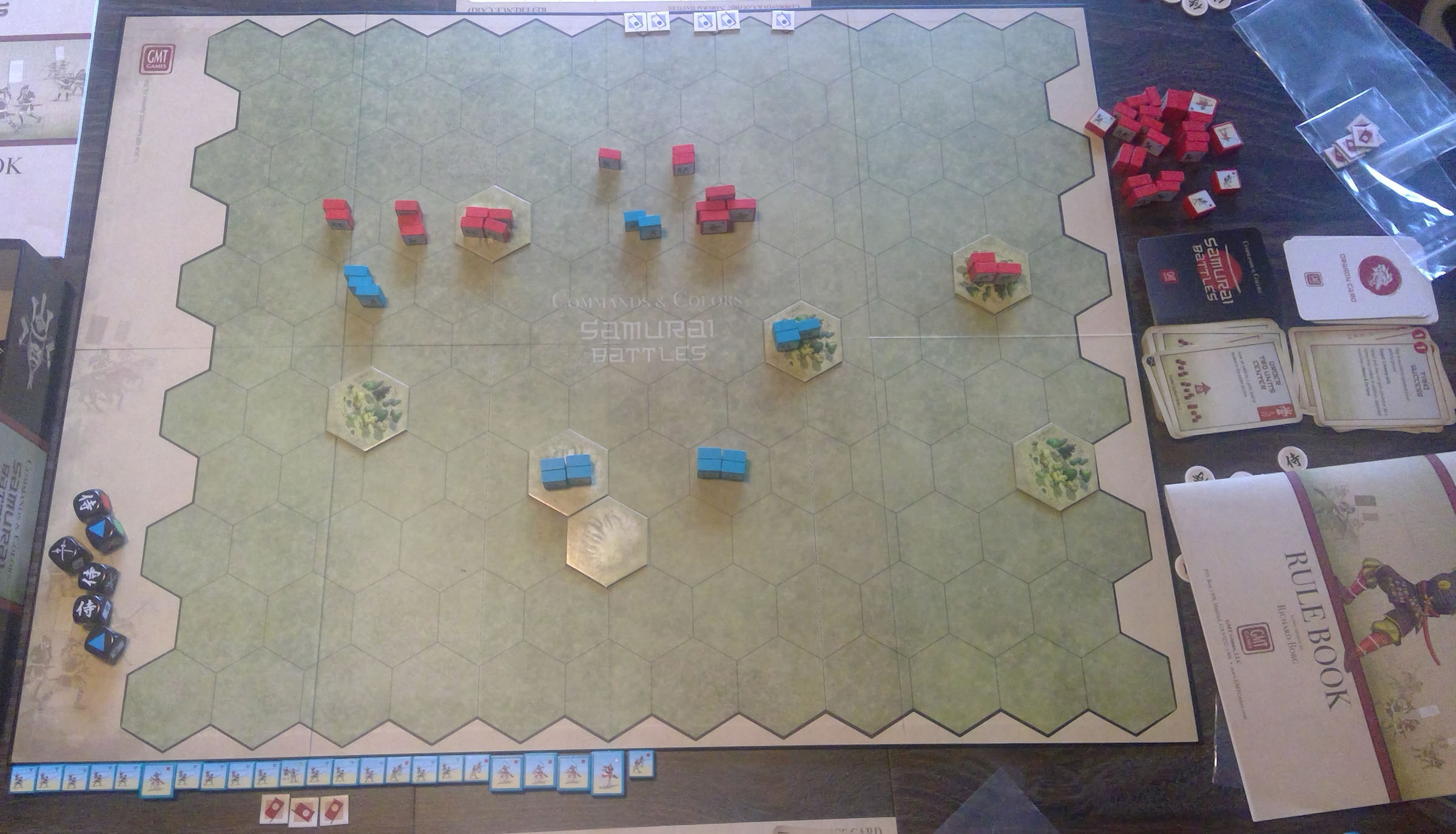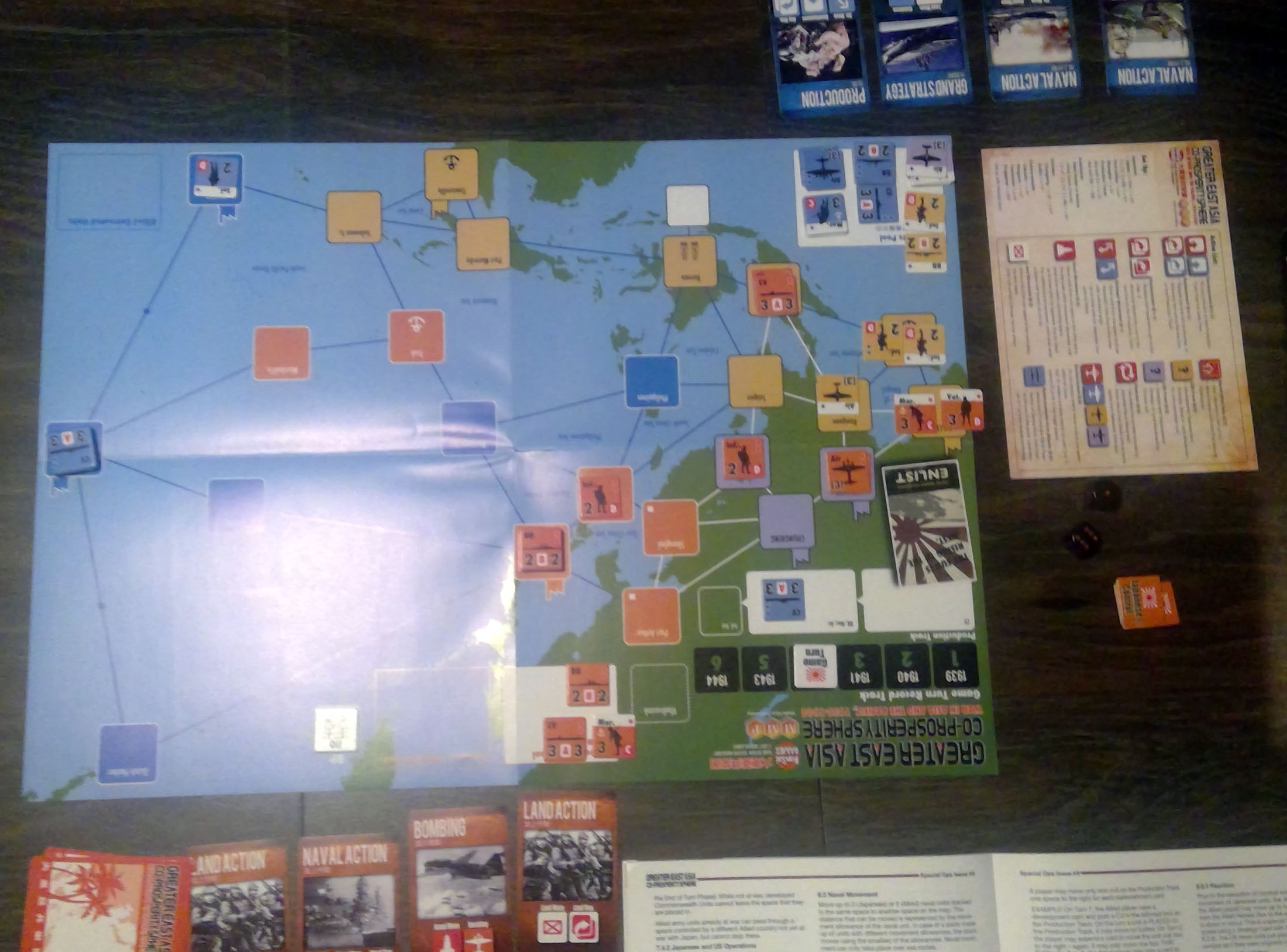East Asia Battles
Mark came over for some one-on-one gaming back on the 28th. The main thing up for the day was to try out his Commands & Colors: Samurai Battles set. Neither one of us had ‘studied’ ahead of time, so we spent a fair amount of time going through the rules, which were generally familiar enough, but with some important differences.
Mostly, it’s a lot like C&C: Medieval. You’ve got the main colors system, leaders attached to units, and the rest familiar from Ancients, but you also have the color- and stature-based ignoring of sword hits from Medieval. You also have “honor & fortune” tokens, which are akin to the “inspired action” tokens of Medieval, but they’re meant to cycle a lot faster than those. Instead of army-based actions, these tokens let you use a second deck of “Dragon Cards”, which have a number of neat actions on them; they can also be used to add a die to any combat with a leader available. And then there’s the fact that there’s no evading, and retreating can be downright dangerous/expensive, as it costs tokens, and if you run out, units start deserting.
Between getting through the rules, and a slowish first game, we just got through one playing of the introductory scenario. Things started badly for me when Mark led off with the C&C:SB equivalent to Darken the Sky, which wiped out an entire Medium unit. I spent what seemed like a lot of time just trying to come to grips his army, and not doing a very good job at first.
I eventually managed to get in and smash his left flank, and then moved things over to concentrate in the center. But Mark got some momentum back, and managed a 3-5 victory with both armies in pretty bad shape.
Thanks to overall lower unit speeds (notably the lack of light cav), and the fact that there’s no evade, and every reason not to retreat, this one feels less maneuver-centric than CC:A and CC:M (though it is there). Because of that, I don’t think this can become my favorite C&C game, but it does hold the promise of delivering well on the period (which I’ve liked ever since Nobunaga’s Ambition), and it comes with a stunning forty scenarios, so I hope we get to really delve into it at some point.

After that, we tried out Greater East Asia Co-Prosperity Sphere (that’s a mouthful, and I don’t have a good nickname for it; saying the name might be the greatest challenge to getting it on the table). I’d partially read the rules about a month earlier, so there was another long bit of going over things, with me able to give some guidance on essential rules.
Generally, the system is pretty neat, and not what you generally see. It’s a very simplified high-level game (one-year turns), where you choose cards that you will then play during the turn (you know, some form of that might make for a good tactical system, instead of being completely at the mercy of card draws in Up Front/Combat Commander…).
I had Japan, and committed myself to knocking out China as fast as I could. There was a bit of wasted motion in that at first, but Mark had some similar problems. By the end of 1941, I’d taken all their home spaces and units, knocking China out of the war. Then in ’42, I declared war on the British and managed to take and hold Calcutta, giving the ‘instant’ goal of holding the home spaces of two different countries.
I’m going to have to look up some reports I remember seeing about this game, because at first glance this seems a tough thing to avoid, though maybe Mark needed to build up a bit faster (a quick Chinese air build might have slowed me down a bit, the bombing action and adjacent air power bonus can have quite an effect—but would it be enough?). I also think that with the way things were obviously going, he should have declared war with the US in 1940. Painful, but he needed the war to expand… and not on my timetable. (The declaration of war segment is a surprisingly important part of the game, and since there can only be one declaration per turn, declaring war on Britain preempted any move by the US).
One major rules question we had was it seems like you can’t ever move anything through neutral spaces, meaning there’s no way for the Japanese to garrison Truk, and no way for the Americans to garrison the Philippines—until war starts. That doesn’t seem like it should be the intention.
I hope I can get a try at playing the Allies at some point to see if I can figure my way out of the ‘Japanese blitz’. Certainly, I like how the different units interact in combat, and it makes for a just deep enough system.


Discussion ¬